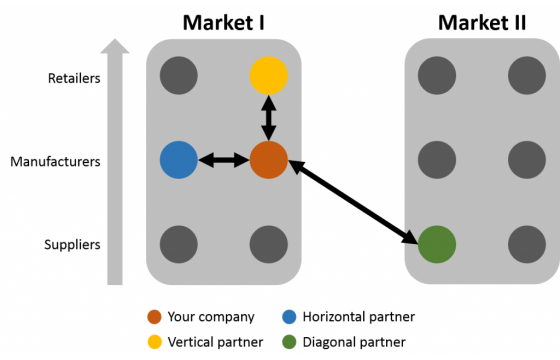Companies can enter into partnerships with different types of organisations and with varying intensity. Possible benefits from partnerships can be access to resources, reduction of risks or the utilisation of economies of scale. Ín regard to the position in the value chain, the relationship between the company and its partner or partners can be horizontal, vertical or diagonal. The intensity of the partnership can vary from a cooperation, collaboration or integration between the company and its partner or partners.
“If you have an apple and I have an apple and we exchange these apples then you and I will still each have one apple. But if you have an idea and I have an idea and we exchange these ideas, then each of us will have two ideas.”— George Bernard Shaw
Companies can enter into partnerships with different types of organisations and with varying intensity. Possible benefits from partnerships can be access to resources, reduction of risks or the utilisation of economies of scale.
Horizontal
Horizontal partnerships can be established to organisations that are on the same stage in the value chain in the same market. For example, two engineering companies in the sanitation sector partner up.
Vertical
Vertical partnerships exist when a company partners with a company on a different stage in the value chain. For example, an engineering company partners with a provider for sanitation equipment.
Diagonal
Diagonal partnerships are found where a company partners with another company which operates in a different market and possibly also on a different stage in the value chain. For example, an engineering company from the sanitation sector partners with a waste management company because they serve the same customers.

Vertical, horizontal and diagonal partnerships in a classic value chain. Source: Own illustration
Subscribe here to the new Sanitation and Water Entrepreneurship Pact (SWEP) newsletter. SWEP is a network of organizations joining hands to help entrepreneurs design and develop lasting water and sanitation businesses.
Cooperation
A cooperation is the least intense type of partnership. It is informal and short-term and each partner retains its own decision-making authority, identity, autonomy and responsibility for its own actions. Very little risk is associated with cooperative efforts, as information is only shared regarding the topic at hand and resources are not shared between organisations.
Example: A group of organisations with similar missions meet regularly to exchange ideas and information regarding issues they address, funding opportunities and service approaches.
Collaboration
A collaboration exists were moderately intense partnerships with formal and long-term characteristics are entered. It is a mutually beneficial and well-defined relationship entered into by two or more organisations to achieve common goals. The relationship includes a commitment to mutual relationships and goals, a jointly developed structure and shared responsibility, mutual authority and accountability for success as well as sharing of resources and rewards. Some risk is involved, since resources are pooled.
Example: In an effort to reduce youth crime, leaders from the local school board, police force, mental health services, and social services form a collaborative body that meets regularly to discuss and implement ways of addressing the issue in a comprehensive manner.
Integration
An integration is the most intense type of partnership with a formal and long-term purpose. The partners merge to create a newly found organisation.They are not only accountable to each other, but operate according to shared regulations and policies specific to the integrative agreement. Each organisation loses its autonomy, as relevant decision-making is carried out through a new common structure. Risk can be an issue, as resources are pooled.
Example: Two start-up incubation centres merge to realise synergies and increase their impact.
(adapted from BUSINESS DICTIONARY NO YEAR).
A business alliance is an agreement between businesses, usually motivated by cost reduction and improved service for the customer. Alliances are often bound by a single agreement with equitable risk and opportunity share for all parties involved and are typically managed by an integrated project team. An example of this is code sharing in airline alliances.
There are five basic categories or types of alliances:
- Sales: A sales alliance occurs when two companies agree to go to market together to sell complementary products and services.
- Solution-specific: A solution-specific alliance occurs when two companies agree to jointly develop and sell a specific marketplace solution.
- Geographic-specific: A geographic-specific alliance is developed when two companies agree to jointly market or co-brand their products and services in a specific geographic region.
- Investment: An investment alliance occurs when two companies agree to join their funds for mutual investment.
- Joint venture: A joint venture is an alliance that occurs when two or more companies agree to undertake economic activity together.
In many cases, alliances between companies can involve two or more categories or types of alliances.
Business Alliance
From Cooperation to Collaboration
Partnership Relationship Management
This paper discusses the characteristics of effective partnership relationships and presents an outline for implementing a plan for success. It also provides a Relational Survey to help determine a partnership’s state of health and provides a Partner Relationship Management Assessment, both as tools for determining an organization’s starting point in relationship management.
DENT, S. M. (2006): Partnership Relationship Management. In: Partnering Intelligence White Paper: URL [Accessed: 17.12.2015]http://www.entrepreneur.com
This webpage gives an introduction into business alliances and guides entrepreneurs via questions about alliances.


